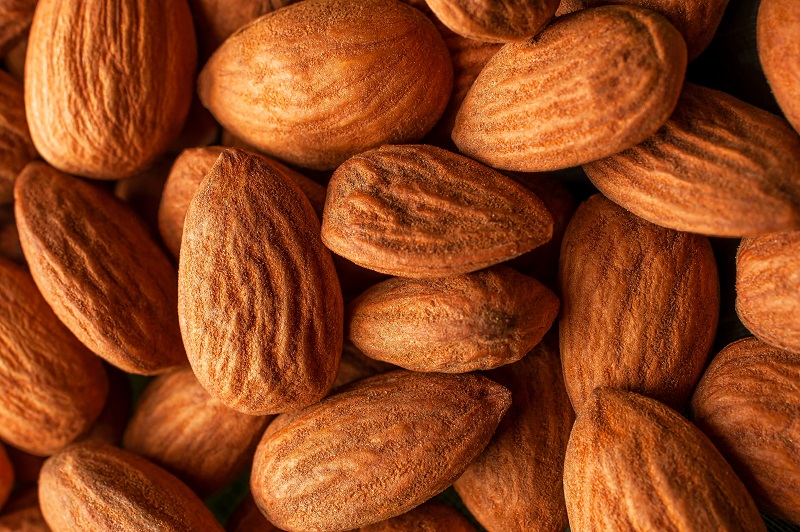Apple Growers Moving to Multileaders
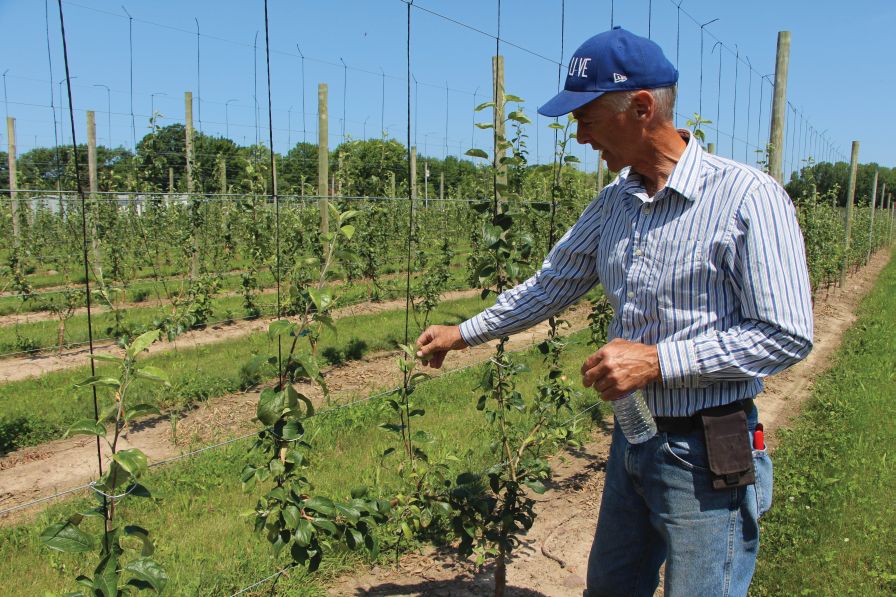
Roger Bannister talks about what he needs to do to get the leaders to reach the top wire of his multileader system. (Photo: Christina Herrick)
Growers throughout the country are renewing orchards at higher and higher densities. You can get big production increases, of course, but planting all of those additional trees is a significant investment.
However, some growers are opting to grow multileader trees. By using a more vigorous rootstock to divert the energy into two or more branches, you can gain the same production advantages of a one-leader, high-density system.
For apple growers, multileader may seem like the answer to the high-density/cost dilemma. This system, however, isn’t without its challenges. We talked with a few growers about what you need to understand up front about making a shift in production systems.
Know What You’re Getting Into
The first thing to know — growers say — is don’t expect to do this on a large scale.
“It’s a substantial commitment to do this,” says Roger Bannister, an apple grower in Kent, NY. “A super spindle is 800 trees per acre. I’ve gone to 3,000 [leaders].”
Bill Nyblad family’s New Leaf Orchards in Kent City, MI, has been experimenting with multileader plantings on their 450 acres following a visit to Italy. As they replant blocks, about a third of the apple acreage is multileader.
Nyblad says the system is just too labor-intensive to go much larger. He estimates his multileader orchards of 3-6 leaders per tree are about double or triple the work of a conventional high-density orchard.
“It’s going to take so much more work than you’ve had to do with any other system,” Nyblad, a third-generation apple grower, says. “If you put in a block that is too big and you don’t have the manpower or the ability to control it, then you’re going to be in trouble.”
Along with the manpower to train the trees properly, there are added costs with additional wires and trellising to support the trees as they grow. Bannister’s son, Robert, is also quick to point out you also have to factor in how long orchard tasks may take.
“Timing is everything. You have to have enough money for labor,” Robert Bannister says. “There is a two-month difference from start to finish [with training our orchard]. The earlier trees got done, the better.”
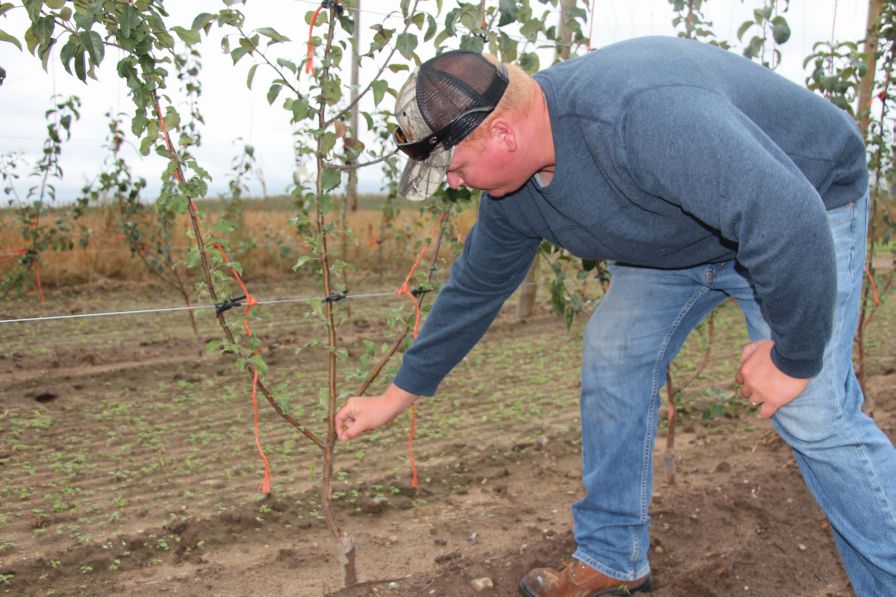
Bill Nyblad explains how the three leaders were created by pinching the top of this tree when it was younger. (Photo: Christina Herrick)
How to Get Started
There are several approaches to getting a multileader tree to work with. The challenge is not many nurseries will grow a multileader tree. Communicate with your nursery in order to see if that’s an option. Otherwise, you can create one yourself.
“You can take a perfectly fine tree and cut it down and it shoots up branches. You can weigh down branches and get leaders to come off of the tree. When you’re grafting over older trees, you can bring up multiple leaders,” Nyblad says.
Bannister says bench-grafting is the best way to ensure that there won’t be any scion roots. He got bitten a couple of times by accidentally training a root sucker, mistaking it for a leader. Bannister also crosses stems because the crotch is stronger to bend down and tie.
Nyblad says he pinches the top of the young trees and lets them grow, instead of chip budding. “I did nothing different 8 inches off the bud union to make a multiple leader tree,” he says.
Growing the Tree
Both growers say it’s important to focus on controlling lateral growth so the tree grows up to the top wire, not out.
“You have to keep the tree within its space for the first couple of years and try not to let large branches start to take over,” Nyblad says. “You need to grow close to the leader because now you’re down to a 2-foot spacing. On a 2-foot spacing, your lateral branches are going to grow a foot to a foot and a half in the first couple of years.”
Bannister says he followed the advice of Alberto Dorigoni — from the Istituto Agrario di San Michele all’Adige in Italy’s South Tyrol province — on supporting his GPS-planted trees approximately 5 feet apart, with leaders every 18 inches apart.
“We followed Alberto’s advice to put cable ties around vigorous branches, one inch apart on the big trunk to boost growth of the weaker two,” he says. “You have to get a bend to change how the tree grows, to slow growth down. A big problem for us is lack of uniformity in leader growth.”
Bannister uses PGRs, such as Apogee (BASF) to curtail lateral growth. He also sprays Promalin (Valent) three times a season to extend shoots. Both sprays are done by hand in order to target exactly where the growth is desired. (For Bannister’s unique application method, see “Innovators Innovating”). He also applies foliar nitrogen at petal fall to encourage that growth to the top wire.
Nyblad says trees will need heavy pruning twice a year in the first three years.
“Almost every branch needs to be addressed,” Nyblad says. “Instead of letting that branch grow two feet, I hedge that branch back in [summer of the] first year, push the production back, and hopefully get three or four branches out of that strong branch that wants to grow too much.”
Both Bannister and Nyblad say cropping is a great way to control vigor and to ensure even growth among the multiple leaders, fruiting on the more dominant leader to slow it down and let the weaker leaders catch up.
In fact, as Roger’s daughter, Jayne, points out, one particular tree was “just vigorous enough we decided to throw another leader and see how close we could go. If we can keep them that close together, that’s another 400 bushels per acre.”
Nyblad says the biggest effort is in the first three years, but it should pay off over the life of the orchard. He expects his multileader system will last longer than a standard single-leader tree which can shade out at the bottom of the tree.
Places for Pitfalls
Mistakes are costly with multileader systems, Bannister and Nyblad say.
“Where most people start running into problems are with too-big branches on the tree in the beginning,” Nyblad says.
It’s also easy to overestimate the size of rootstock you’ll need, Nyblad says. Dwarfing rootstocks will work just fine in a multileader system, and you run the risk of losing the dwarfing characteristics if you go too large.
“I’ve planted ‘Honeycrisp’ on G.30 and I’m not confident that the Nic 29 or the G.11 weren’t a better way to go. I’m still fighting lateral growth and excessive vegetation and those are the things that cause bitter pit,” he says. “I don’t know if I’ve settled that large, G.30 rootstock down even with the two leaders and keeping it inside of a 12-foot spacing.”
Would You Do It?
“I told Dad it was going to save him money,” Nyblad says of his father, Nick, who was reluctant to go as close on spacing as Bill and his brother, Gunnar, thought was optimal. Their solution was to move to a 2-foot-by-14-foot multileader system.
Bannister’s approach was inspired by reading about multileader systems while he was battling cancer. He was intrigued by the promise of increased light interception and production, as his current system was struggling to color up properly.
“A lot of what I read made sense, it was well worth trying,” he says. “I have a different perspective since I had cancer. I enjoy being able to work. I’d rather be in the orchard experimenting to figure out what works best.”
For Bannister, pruning has become much more simplified. For larger varieties like ‘Honeycrisp,’ he estimates he needs six to eight buds per leader for each wire spacing, and then thinning down to eight apples per wire spacing for each leader; he’s estimating getting yields of 1,500 bushels to the acre, substantially higher than his current 600-800 bushels per acre. Bannister has anywhere from has three to six leaders on his multileader trees.
“The fruit bud formation for next year’s crop is just as important as this year’s color,” he says. “Hopefully, everything is going to be more uniform.”
Robert Bannister says the family, which includes sisters Jayne and Emily, is learning a lot and sharing what worked and what hasn’t.
But for the grower who is still debating what to do, Roger Bannister says: “I say go for it. We just went ahead and did it.”
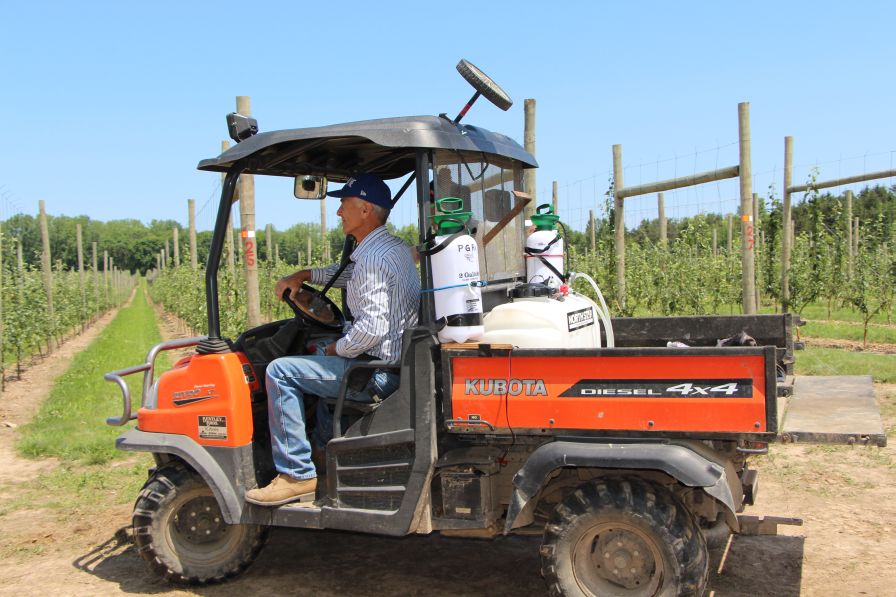
Roger Bannister sprays PGRs down the row with help from his daughter, Jayne from his retrofitted ATV. (Photo: Christina Herrick)
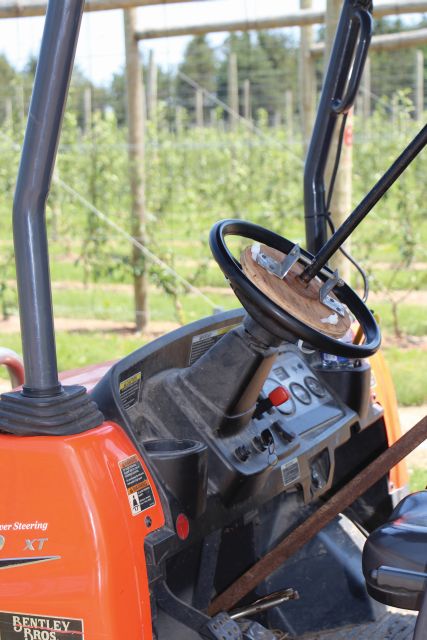
Roger Bannister’s retrofitted steering wheel allows him to operate his ATV from the back of the cab. (Photo: Christina Herrick)
Innovators Innovating
Roger Bannister of Kent, NY, says he used the standard apple bin size as the dimensions of how far apart he was going to space his orchard.
“We started with bin size, and made it work,” he says.
Roger’s son, Robert says with 8.5 foot spacing between rows, that meant a lot of standard-sized equipment did not work for the multileader system.
“We had to build a lot of our own equipment,” he says.
Roger Bannister made a weed cultivator to fit his orchard, and a root pruner to help slow down growth.
But perhaps his best innovation was retrofitting a self-driving all-terrain vehicle (ATV) to help him build the trellis and apply plant growth regulators in specific locations on his trees. A long iron rod controls the gas pedal and another rod, which extends from a covering on the steering wheel (out the back window of the ATV, maneuvers the vehicle. Both rods are long enough that he can reach them in the back of the cab and can use them to drive the ATV down the rows.
Someday soon Robert hopes autonomous tractors and harvesters will replace a lot of the devices they’ve had to build.
“I’m anxiously awaiting for technology to come to this orchard,” he says.







